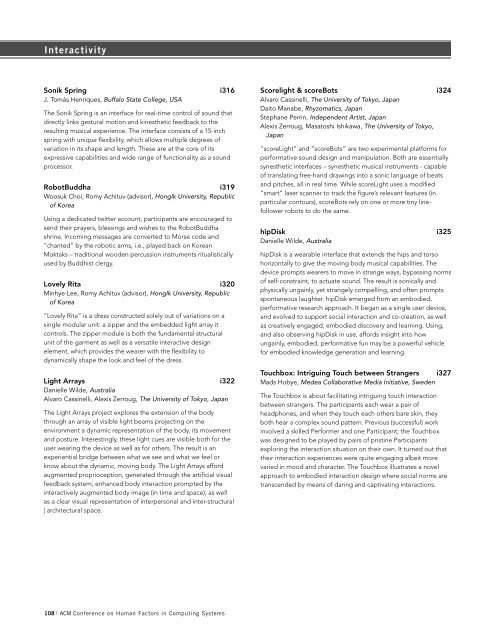Printed Program (pdf) - CHI 2012 - Association for Computing ...
Printed Program (pdf) - CHI 2012 - Association for Computing ...
Printed Program (pdf) - CHI 2012 - Association for Computing ...
Create successful ePaper yourself
Turn your PDF publications into a flip-book with our unique Google optimized e-Paper software.
Interactivity<br />
Sonik Spring i316<br />
J. Tomás Henriques, Buffalo State College, USA<br />
The Sonik Spring is an interface <strong>for</strong> real-time control of sound that<br />
directly links gestural motion and kinesthetic feedback to the<br />
resulting musical experience. The interface consists of a 15-inch<br />
spring with unique flexibility, which allows multiple degrees of<br />
variation in its shape and length. These are at the core of its<br />
expressive capabilities and wide range of functionality as a sound<br />
processor.<br />
RobotBuddha i319<br />
Woosuk Choi, Romy Achituv (advisor), HongIk University, Republic<br />
of Korea<br />
Using a dedicated twitter account, participants are encouraged to<br />
send their prayers, blessings and wishes to the RobotBuddha<br />
shrine. Incoming messages are converted to Morse code and<br />
“chanted” by the robotic arms, i.e., played back on Korean<br />
Moktaks – traditional wooden percussion instruments ritualistically<br />
used by Buddhist clergy.<br />
Lovely Rita i320<br />
Minhye Lee, Romy Achituv (advisor), HongIk University, Republic<br />
of Korea<br />
“Lovely Rita” is a dress constructed solely out of variations on a<br />
single modular unit: a zipper and the embedded light array it<br />
controls. The zipper module is both the fundamental structural<br />
unit of the garment as well as a versatile interactive design<br />
element, which provides the wearer with the flexibility to<br />
dynamically shape the look and feel of the dress.<br />
Light Arrays i322<br />
Danielle Wilde, Australia<br />
Alvaro Cassinelli, Alexis Zerroug, The University of Tokyo, Japan<br />
The Light Arrays project explores the extension of the body<br />
through an array of visible light beams projecting on the<br />
environment a dynamic representation of the body, its movement<br />
and posture. Interestingly, these light cues are visible both <strong>for</strong> the<br />
user wearing the device as well as <strong>for</strong> others. The result is an<br />
experiential bridge between what we see and what we feel or<br />
know about the dynamic, moving body. The Light Arrays af<strong>for</strong>d<br />
augmented proprioception, generated through the artificial visual<br />
feedback system; enhanced body interaction prompted by the<br />
interactively augmented body image (in time and space); as well<br />
as a clear visual representation of interpersonal and inter-structural<br />
| architectural space.<br />
108 | ACM Conference on Human Factors in <strong>Computing</strong> Systems<br />
Scorelight & scoreBots i324<br />
Alvaro Cassinelli, The University of Tokyo, Japan<br />
Daito Manabe, Rhyzomatics, Japan<br />
Stephane Perrin, Independent Artist, Japan<br />
Alexis Zerroug, Masatoshi Ishikawa, The University of Tokyo,<br />
Japan<br />
“scoreLight” and “scoreBots” are two experimental plat<strong>for</strong>ms <strong>for</strong><br />
per<strong>for</strong>mative sound design and manipulation. Both are essentially<br />
synesthetic interfaces – synesthetic musical instruments - capable<br />
of translating free-hand drawings into a sonic language of beats<br />
and pitches, all in real time. While scoreLight uses a modified<br />
“smart” laser scanner to track the figure’s relevant features (in<br />
particular contours), scoreBots rely on one or more tiny linefollower<br />
robots to do the same.<br />
hipDisk i325<br />
Danielle Wilde, Australia<br />
hipDisk is a wearable interface that extends the hips and torso<br />
horizontally to give the moving body musical capabilities. The<br />
device prompts wearers to move in strange ways, bypassing norms<br />
of self-constraint, to actuate sound. The result is sonically and<br />
physically ungainly, yet strangely compelling, and often prompts<br />
spontaneous laughter. hipDisk emerged from an embodied,<br />
per<strong>for</strong>mative research approach. It began as a single user device,<br />
and evolved to support social interaction and co-creation, as well<br />
as creatively engaged, embodied discovery and learning. Using,<br />
and also observing hipDisk in use, af<strong>for</strong>ds insight into how<br />
ungainly, embodied, per<strong>for</strong>mative fun may be a powerful vehicle<br />
<strong>for</strong> embodied knowledge generation and learning.<br />
Touchbox: Intriguing Touch between Strangers i327<br />
Mads Hobye, Medea Collaborative Media Initiative, Sweden<br />
The Touchbox is about facilitating intriguing touch interaction<br />
between strangers. The participants each wear a pair of<br />
headphones, and when they touch each others bare skin, they<br />
both hear a complex sound pattern. Previous (successful) work<br />
involved a skilled Per<strong>for</strong>mer and one Participant; the Touchbox<br />
was designed to be played by pairs of pristine Participants<br />
exploring the interaction situation on their own. It turned out that<br />
their interaction experiences were quite engaging albeit more<br />
varied in mood and character. The Touchbox illustrates a novel<br />
approach to embodied interaction design where social norms are<br />
transcended by means of daring and captivating interactions.


